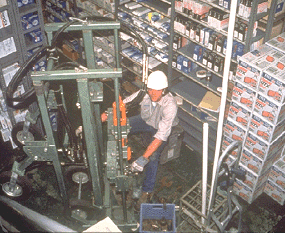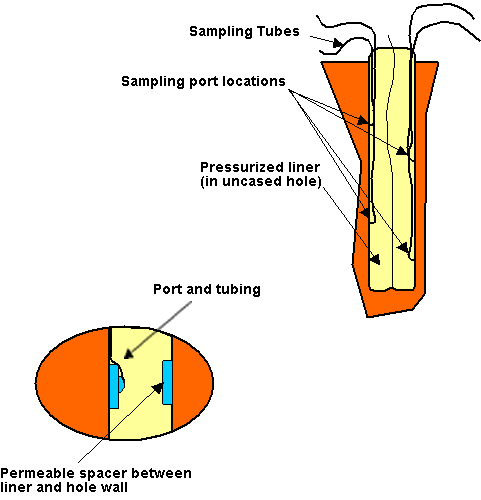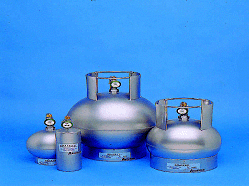Soil and Soil-Gas Samplers
- Direct-Push Technologies
- Explosives
- Fiber Optic Chemical Sensors
- Gas Chromatography
- Geophysical Methods
- High-Resolution Site Characterization (HRSC)
- Immunoassay
- Infrared Spectroscopy
- Laser-Induced Fluorescence
- Mass Flux
- Mass Spectrometry
- Open Path Technologies
- Passive (no purge) Samplers for Groundwater
- Test Kits
- X-Ray Fluorescence
Introduction
 Percussion hammer direct-push system. Courtesy of Geoprope Systems. |
Direct-push platforms have gained widespread acceptance in the environmental industry over the past decade because of their versatility, relatively low cost, and mobility. Using the weight of the truck in combination with a hydraulic ram or hammer, a tool string is pushed into the ground.
Description
The two major classes of direct-push platforms are cone penetrometer (CPT) and percussion hammer systems. The distinction between these units is that CPT units advance the tool string by applying a hydraulic ram against the weight or mass of the vehicle alone, while percussion hammer units add a hammer to the hydraulic ram to compensate for their lower mass. These platforms share the same principle of operation, similar tools, and a number of advantages and limitations. They differ in scale, application, and to some extent the types of instruments and tools that have been developed for each. For these reasons, CPT and percussion hammer platforms fill different niches in the environmental field. CPT rigs can generally push to greater depths and push larger-diameter rods; they allow sampling from depths that are inaccessible using percussion hammer rigs. Percussion hammer rigs are generally smaller, more portable, and require less training to use; they allow samples to be collected from places, including inside of buildings, that are inaccessible to a CPT rig. Although they are sometimes limited in the depths to which they can penetrate, some of the smaller percussion hammer units as well as smaller CPT rigs can be anchored to the ground using earth augers to add to the reaction mass of the vehicle alone.
In general, types of sampling tools and methods of sampling are very similar; when a new technology is developed for one system, it is usually adapted for the other. For more detail about how direct-push technology works, see the Direct-Push Platform encyclopedia entry.Typical Uses
 Hand truck percussion hammer rig. Courtesy of Precision Sampling. |
Because of their methods of operation, direct-push systems provide some unique advantages when collecting soil and soil-gas samples. In particular, direct-push systems are quicker and more mobile than traditional drill rigs. Sampling and data collection are faster, reducing the time needed to complete an investigation and increasing the number of sample points that can be collected during the investigation. Soil sampling systems have been developed in response to a need to collect samples of unconsolidated material from a range of depths, without generating large volumes of cuttings. Direct-push soil samplers also allow investigators to collect soil samples from a specific depth, with minimal disturbance to soil stratigraphy. Soil-gas sampling systems are used to collect samples of vadose-zone gases for analysis at the surface, or to permit real-time chemical monitoring of soil gases in conjunction with direct-push analytical sensors. Some of the most powerful tools for site characterization combine the ability to collect soil-gas, soil, and groundwater samples from the same borehole.
Soil Sampling Tools
Direct-push soil sampling systems have been developed by several vendors to collect soil samples from a discrete depth, without removing overlying soil. Typical uses of direct-push soil sampling systems include site assessment activities at sites where soils are reasonably suspected to be contaminated, sites where contamination is confined to a discrete depth range, or sites where the available sampling area is limited. For instance, sites with heavily contaminated soil that may warrant disposal as hazardous waste may benefit from the low volume of soil removed from the ground by direct-push soil samplers and the lack of cuttings typically generated by other drilling and sampling methods. Samplers are available in a variety of diameters and lengths, allowing for collection of varying sample volumes. Most soil sampling tools use a similar design, with technical refinements to increase sampling rates and decrease cross-contamination.
Piston-Activated Systems
The simplest soil samplers make use of a piston-activation mechanism. In this system, the tool consists of a hollow sample tube with a retractable drive point. The drive point is connected to a narrow piston rod that runs the length of the sample tube and is attached to a stop-pin at the uphole end of the tool. The tool is advanced to the desired depth, at which time the operator uses extension rods lowered through the drive rods to unscrew the drive point-piston rod assemblage. The drive point may be drawn back a small distance to create a slight vacuum, thereby increasing sample recovery rates. With the drive point loosened, the tool is then driven by the cutting shoe, a sharpened edge on the open sample tube. The tool is advanced the required depth to fill the open sample tube with unconsolidated material. When full, the entire assemblage is brought to the surface.If samples are needed from deeper layers, the entire process is repeated, introducing the possibility of cross-contamination if the sample must be collected from the same borehole. After the tool is removed, sidewall material may slough into the borehole; fall-in is less likely in cohesive sediments. The acceptability of sloughing cross-contamination should be decided on a case-by-case basis, depending on data quality objectives. If this minimal amount of cross-contamination is not acceptable, samples must be collected from another borehole.
Split spoon samplers split into two hemicylindrical pieces, allowing the soil or sediment to be directly accessed. Most tools can also be used with acetate or metal liners that are pushed out of solid sample tubes or directly accessed in split spoon samplers. Once the soil sample is removed, the sample tool is decontaminated and reintroduced into the borehole to sample other depths or moved to another location.
 Split sampler with acetate liner. Courtesy of Geneq. |
Latch-Activated Systems
Latch-activated systems are similar to those that use piston-activation mechanisms, but they can collect samples more rapidly. Because they are sensitive to vibration, they generally cannot be used with percussion hammer platforms. In latch-activated systems, the drive point is connected to the downhole end of the tool, using three retractors. Once the tool has been pushed to the desired depth, it is pulled back 2 inches, unlocking the drive point from the sample tool. As the tool is advanced, the unlocked drive point is pushed up into the hollow sample tube by the soil and sediment filling the sampler. The tool and the soil sample are then brought to the surface. Latch-activated systems are faster to use, but the length of the sampling tube is shortened by the length of the drive point, about 3 inches.
Dual-Tube Systems
Sampling rates can also be increased by using dual-tube samplers. Dual tube systems consist of an outer drive casing and inner drive rods. The rods can be attached to either a drive point or a barrel sampler with liners. In the drive point mode the tool is driven to the desired sampling depth where the drive point is withdrawn and replaced with the barrel sampler. The outer casing and sampler are then driven the length of the sample tube (three to five feet depending upon the equipment) at which point the sample tube is withdrawn. Continuous sampling can be carried out quickly by using multiple samplers. The dual-tube sampling system is recommended for continuous sampling as the outer casing prevents sloughing and cross contamination from other depths.
Soil-gas Sampling Tools
Direct-push soil-gas sampling tools can substantially increase the accuracy and precision of sampling in other media, as well as providing information about vadose-zone contaminants. In particular, soil-gas studies have been shown to provide valuable data on the distribution and concentration of volatile organic compounds (VOC) in soil and groundwater. By detecting elevated concentrations of VOCs in soil gases, investigators are better able to choose locations for soil and groundwater sampling, especially when on-site laboratory facilities are available to analyze vapor samples. Soil-gas sampling is especially valuable in areas in which the waste disposal history is not well known and time or resources for sampling soil or groundwater are limited. In addition to its use in guiding soil and groundwater sampling, direct-push-installed soil-gas samplers can be used as part of a vapor-monitoring program, for example, those used in and around landfills.
Samplers can be divided into two basic classifications—continuous and discrete. Continuous sampling tools are driven in sniffing mode; that is, vapor samples are collected as the tool is driven. For discrete sampling, the tool is driven to the target depth, and the sample is collected. Depending on the vapor sampler selected, the tool may be pushed to the next sampling depth or removed and decontaminated before it is used again. Discrete tools may be used multiple times in the same borehole if the hole remains open between sampling.
Discrete tools have the advantage of collecting a sample from a precise depth, more accurately locating the source of contamination. Continuous tools have the advantage of more quickly characterizing a soil sequence. However, continuous sampling tools have also been found to experience more false positive results than discrete sampling tools due to residual VOCs in vapor transfer tubes.
Continuous Sampling Tools
Continuous sampling tools consist of a filter-probe module located immediately behind the drive point. Gases enter the probe and are brought to the surface using pumps or inertial displacement. These tools can be used to collect groundwater as well as soil gases. When sampling is complete, the tool is advanced to the new target depth. This system has the advantage of collecting soil-gas samples at multiple depths while simultaneously obtaining soil stratigraphy with geotechnical sensors. Vapor samples can be analyzed as they are collected using photo- or flame-ionization detectors, collected into a syringe, syringe vial, or tedlar bag for analysis by gas chromatography in the field, or collected into Summa canisters for analysis by off-site laboratories.
|
Stainless-steel Summa canisters for collecting soil vapors. Courtesy of Thermo Andersen. |
Continuous sampling provides the advantages of speed and convenience. However, with some tools, organic vapors may be diluted by other gases in the sampling rods, and false positives may be recorded as a result of residual VOCs in sampling equipment. In addition, sampling ports may become clogged with sediment when sampling in fine-grained soil or sediment, reducing the chances of collecting quality samples.
Discrete Sampling Tools
The common discrete-interval soil-gas tool consists of a steel tip that screws into the end of the tool string and holds a disposable drive point. The tool is advanced to the desired sampling interval and then retracted as the drive point is held in place. By retracting the tool, soil is exposed below the opening of the sample chamber; a vapor sample is collected using a vacuum pump and disposable tubing that opens into the sample chamber. The tool is then brought back to the surface. After decontamination, a new drive point can be mounted on the tool and the tool can be redriven to sample other depths or moved to another location. A vapor sample may also be collected by gas transfer tubes that transport soil gas to the surface using an inert carrier gas such as nitrogen. These vapors may be analyzed onsite or trapped for later analysis. Another configuration uses a retractable probe but the tip is not disposable and following the sample taking they are reattached for further probing. This tool also allows for downhole replacement of the tubing without having to bring the probe to the surface.
Technical innovations have improved on this basic design. In some systems, a dual-tube arrangement can be used to retrieve all drive mechanisms and to hold open the gas sampling chamber. This arrangement is helpful in areas with loose soil or sediment which is likely to collapse into the sampling area. Some soil-gas sampling tools have screened sampling ports to keep sampling chambers clear. Other vapor sampling tools use gas permeable membranes that allow soil gas to enter sampling chambers while excluding sediment. Collected vapors are then transferred to the surface for onsite analysis.
Permanent Soil-Gas Monitoring Tools
Direct-push platforms can also be used to install systems to monitor soil gases around underground storage tanks or as part of an ongoing remediation effort. They may also be used in relatively impermeable soils in which longer times are needed for VOCs to migrate into the sample chamber. These long-term sampling tools may be simple vadose-zone wells from which vapor can be extracted or more complicated multiport or multilevel samplers. A multiport sampler sleeve and a deflated membrane are emplaced using the probe rods. Holding the assemblage in place, the rods are retracted, and the membrane is inflated, usually with water. This pushes the multilevel sampler to the side of the borehole. Small sampling tubes are pushed down into sleeves to the depth of the perforations. Samples from a range of depths can then be collected from a single borehole.
 Multiport sampler. Courtesy of Flexible Liner Underground Technologies. |
Combined Systems
Soil-gas sampling systems have also been developed as part of multiple-use sampling tools. The Simulprobe soil sampler can be used in its "drive and sniff" mode, allowing soil gases to be continuously collected while advancing the sampler into the subsurface. Based on the field screening of the soil-gas sample, a collocated soil sample can be immediately collected. Similarly, the ConeSipper can be used to collect soil-gas samples in the vadose zone, then collect groundwater samples as the tool advances below the water table. Finally, most dual-tube sampling systems can be used for alternating soil and soil-gas sampling.
Advantages
Soil and soil-gas sampling using direct-push technology provides many advantages over sampling using conventional methods. Direct-push systems are quicker and more mobile than traditional drill rigs. Small percussion hammer rigs can even be used to sample inside buildings. The smaller footprint of direct-push rigs also minimizes surface and subsurface disturbance. Sampling and data collection are faster, reducing the time needed to complete an investigation and increasing the number of sample points that can be collected during the investigation. Closed sampling systems and on-board analytical instruments allow soil-gas samples to be analyzed in the field, avoiding laboratory turnaround time, remobilization time, and associated expenses. Soil and groundwater samples can then be collected immediately from the area of suspected contamination, based on soil-gas results.
For all these reasons, direct-push technologies are particularly well suited for application of the Triad Approach to site investigations for sites with shallow subsurface contamination in unconsolidated soils and sediments. The Triad Approach makes use of on-site analytical tools, in conjunction with systematic planning and dynamic work plans, to streamline sampling, analysis, and data management conducted during site assessment, characterization, and cleanup. Field analysis in general and direct-push systems in particular are often used to speed collection and reduce costs on projects where the sites are large, a high volume of data points are needed, the sites are partly or totally inaccessible by a large drill rig, or to minimize sampling disturbances in sensitive habitats.
Limitations
In spite of its advantages, soil and soil-gas sampling using direct-push technologies does have limitations that are specific to the direct-push platform. Because of the nature of direct-push drilling, investigators may be unable to collect samples from consolidated materials, and, in general, direct-push rigs are limited to depths of less than 100 feet. In addition, soil or sediment sampling in areas with significant soil calcification is problematic.
Cost Data
Studies indicate that direct-push sampling systems may provide significant savings over conventional methods. Cost information varies greatly among the different technologies as well as for projects of different scope.





